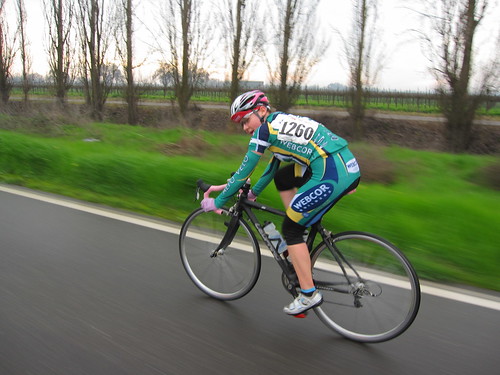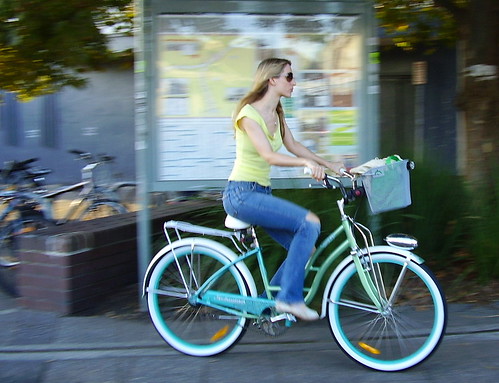The Sport/Recreational Cyclist:

This is often the image that comes to people's minds, at least here in the US, when you say the word "cyclist"- folks dressed in lycra pants and jerseys (often covered in logos), riding for the purpose of riding, and usually for the purpose of going far and fast. You often see packs of these folks out on our roadways on any given weekend, and a 40-50 mile ride is commonplace for them. They aren't trying to go anywhere in particular, or if they are (as is often the case- they meet up at the bagel shop in the Canyon Crest Towne Centre), they're doing it via a long and circuitous route designed to provide exercise. Often, they are competitive cyclists that compete in organized races, and are riding as part of a training program. Organized clubs of cyclists like these are very common, and Riverside hosts a very large one, as do many other IE cities. Recreational cyclists can often be seen advocating for cycling facilities along roadways, such as bike lanes and bike route signage, and are often the primary impetus behind recreational trails like the Santa Ana River Trail and the Victoria Avenue bike path. They can also be seen driving to ride meeting locations with bikes on car-mounted racks, and driving away again afterwards. While they are all cyclists on the weekends, many are the very motorists I am fighting against on the weekdays. And one last thing- the fact that many people think of recreational cycling when (if) they think of cycling at all leads to the impression that cycling is a sport (requiring special clothing, like Lycra pants), and that bicycles are toys or sporting goods (not serious tools for transportation).
The Utility Cyclist:

This young lady in Sydney, Australia demonstrates nicely the differences between the recreational cycling that already exists, and the sort of utility cycling that we need desperately to advocate for. Notice first the differences in equipment- she's wearing everyday street clothing, and her bicycle is obviously designed for comfort and carrying capacity (unlike racing cycles, which are often designed to be as light as possible, and omit such niceties as cargo racks and baskets). Second, the girl in the second photo looks entirely natural- while she's riding a bicycle, the bicycle is not the point of whatever outing she's on. This is the difference between driving a car in a rally or race, and simply running errands around town. Now, the girl in the second photo is actually making a "trip" that would otherwise have to be accomplished by automobile, and she has different needs from the sport cyclist. For example, she'll probably be parking her bicycle wherever she's going, rather than simply returning home or to her car's bicycle rack, so she'll need secure bicycle parking. Second, she's probably got a specific destination or two in mind, so she can't always just plan her route based on where the city has provided cycle facilities. If you're just out to ride 50 miles, then 50 miles on the Santa Ana River Trail are as good as any other miles, and you'll probably avoid roads without cycle facilities as much as possible. If, however, you're meeting friends at a restaurant, you might find that the street that restaurant is on has no bike lanes. I am always annoyed at the location of the Santa Ana River Trail- I love to ride it, because it's quiet, well-maintained and car-free, but it doesn't *go* anywhere- in most cases I'd have to ride to the other side of the city, take the trail, and then ride halfway back across the city. (I find Victoria a touch more useful, but it still has this problem.)
The point is that the needs of different classes of cyclists are very different, and we should be actively encouraging cycling specifically as a form of transportation. While recreational cycling is undoubtedly a good thing (it keeps people healthy and has supported a vibrant bicycle & bike part market, and it's fun!), it is not the sort of cycling that creates vibrant urban environments and solves our transportation and land use problems.
Photos are courtesy of swoo and Velovotee via Flickr, used under Creative Commons. See original photo pages for license details.



3 comments:
Should say my dad also cycled for health/medical reasons. While he was young he had an accident which caused him to lose the front half of one foot. Therefore my dad cycled for utility/transportation, as well as to keep his leg muscles intact, and for overall health, to shop, and sometimes recreationally.
My main cycling was to get to work or the store or to get to where I kept my horse to feed him morning and night and to get to classes while in college both when I lived on and off campus. My bicycle was a 10 speed, but with fenders front and back, with a rack on the back which I could put things or tie things down. My dad also showed me a safe way to use bags on the front bars to safely carry food home from the store.
When we traveled through the romantic part of Europe for recreation, we did all of our traveling from Cologne Germany on bicycles, except for riding down the Rhine, and stayed in youth hostels. We had bags over the rack in the back, and as I recall may have had a bag over the back. Don't recall if we had bags over the front or not.
I am female but rode a man's 10 speed to work at a professioinal job. So I did not cycle in jeans but my work clothes or in some instances changed at work and brought my clothes with me. I worked on the 9th or 10th floor of a highrise at the time near SF City Hall, and parked my bicycle in the underground parking area of the highrise.
I was one of few bicycling at the time in SF, but since that time there are tons of professionals, high paid folks, using Utility/transportation bicycling to
-- get to work
-- to keep physically fit
-- to get to work FASTER, at LESS COST as they don't have to worry about paying for GAS, PARKING TICKETS, DAILY OR MONTHLY FEES FOR A PARKING SPACE PARKING FEES (can be as high as around $70 or $80 a day in San Francisco's Financial District Embarcadero Center for folks who just drop in for the day), and also have more options when they leave work to be able to go somewhere after work without worrying about parking a car.
Other advantages to bicycling to work are that you SEE the community and the people who live there in much greater detail. You are more a part of the community when you bicycle and learn the subtleties of neighborhoods.
Should say riding a 10 speed you may not be riding sitting upright, but may be trying to make time while keeping save, avoiding doors of parked cars, etc. Most folks utility riders who are riding bicycles to work, would likely be riding somewhere between the recreational cyclist and the utilty cyclist.
BAY AREA
A friend of mine normally is a utility cyclist riding from her home several miles to her job on the Stanford University Campus in Palo Alto, CA. That community and communities like Davis CA and Portland, OR are going after opportunities to improve the experience for utility Cyclists as well as recreational cyclists. Those Communities and/or others are dealing with ISSUES of underpasses and overpasses that were NOT designed with cyclists in mind and that is a very expensive matter. Come communities like Copenhagen, I believe are building high rise garages for folks that ride bicycles.
Want to see photos of a variety of types of Utility/Transporation cyclists, look at these Cophenhagen threads on Craigslist's worldwide bicycling discussion forum.
This http://inlandempire.craigslist.org/forums/?act=RSR&forumID=95&SQ=copenhagen&offset=60 is a search of Craigslist's Bicycling Discussion Forum, seaching for the word "Copenhagen".
When you click it will redo that search and will search through the most recent 100,000 posts or some many months posts or something to that effect.
A thread of mine on CL's Bicycling Discussion Forum from June 2007 about a Wall Street Journal article on cycling http://inlandempire.craigslist.org/forums/?ID=65454132
thread text below:
inl Visitor : WSJ article making your city bicycle < twodogkd > 2007-06-10 12:15:46
Building a Better Bike Lane Bike-friendly cities in Europe are launching a new attack on car culture. Can the U.S. catch up?
By NANCY KEATES May 4, 2007;
Page W1, Wall Street Journal
http://online.wsj.com/article_email/SB117823466296891497-lMyQjAxMDE3NzA4NDIwMzQ0Wj.html
Some excerpts
. . . "COPENHAGEN -- No one wears bike helmets here. They're afraid they'll mess up their hair. "I have a big head and I would look silly," Mayor Klaus Bondam says." ...
"The city of Copenhagen plans to double its spending on biking infrastructure over the next three years, and Denmark is about to unveil a plan to increase spending on bike lanes on 2,000 kilometers, or 1,240 miles, of roads. Amsterdam is undertaking an ambitious capital-improvement program that includes building a 10,000-bike parking garage at the main train station -- construction is expected to start by the end of next year. The city is also trying to boost public transportation usage, and plans to soon enforce stricter car-parking fines and increase parking fees to discourage people from driving." ...
"Officials from some American cities have made pilgrimages to Amsterdam. But in the U.S., bike commuters face more challenges, including strong opposition from some small businesses, car owners and parking-garage owners to any proposals to remove parking, shrink driving lanes or reduce speed limits. Some argue that limiting car usage would hurt business. "We haven't made the tough decisions yet," says Sam Adams, city commissioner of Portland, Ore., who visited Amsterdam in 2005. There has been some movement. Last month, New York Mayor Michael Bloomberg announced a proposal to add a congestion charge on cars and increase the number of bicycle paths in the city. It would also require commercial buildings to have indoor parking facilities for bikes." ...."
What, EXACTLY, is YOUR community doing to make your area more bicycle friendly?
Thanks for laying this out so clearly.
Post a Comment